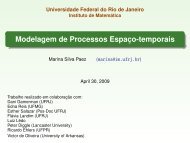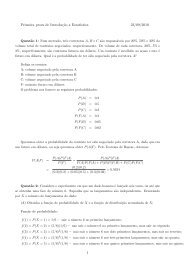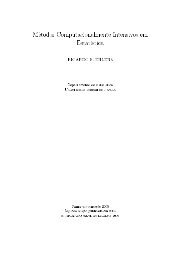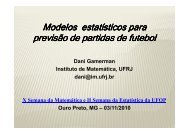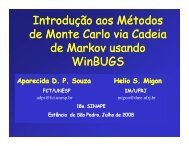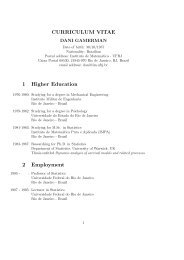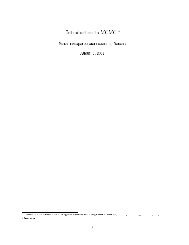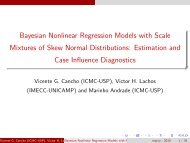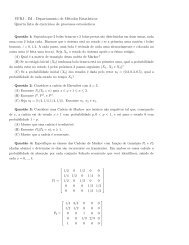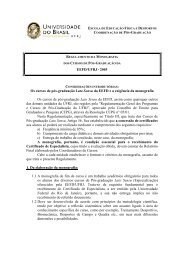Copulas: a Review and Recent Developments (2007)
Copulas: a Review and Recent Developments (2007)
Copulas: a Review and Recent Developments (2007)
Create successful ePaper yourself
Turn your PDF publications into a flip-book with our unique Google optimized e-Paper software.
<strong>and</strong> the non-exchangeable copula (ALM) associated to the asymmetric logistic model,seeTawn(1988)<strong>and</strong>Mendes(2005). UsingtheAICcriterionwefoundthebestcopula¯t as the Gumbel copula with ± =1:35, <strong>and</strong> tail dependence coe±cient ¸U =0:33.To assess the e®ects of volatility, the univariate data are previously ¯ltered usingthe Fractionally Integrated GARCH (FIGARCH) model. This °exible class ofmodels, able to capture the e®ects of long memory (or fractional integration) in theconditional variance, was introduced by Baillie et al. (1996), <strong>and</strong> Bollerslev <strong>and</strong>Mikkelsen (1999). To de¯ne a FIGARCH process, let fX t g t2Z be a stochastic processwith zero mean <strong>and</strong> X t = ¾ t Z t ,whereZ t is an independent identically distributedr<strong>and</strong>om variable with zero mean <strong>and</strong> unit variance, such that X t jF t¡1 are independentidentically distributed with mean 0 <strong>and</strong> variance ¾t 2 ,whereF t¡1 denotes the ¾-¯eldof the information set up to time t ¡ 1. Let º t = Xt 2 ¡ ¾t 2 . The conditional volatility¾ t of a FIGARCH(r; d; s) processisde¯nedford 2 [0; 1] throughwith¾ 2 t = ! (1 ¡ ¯(L)) ¡1 + ¸(L)X 2 t ;¸(L) =1¡ (1 ¡ ¯(L)) ¡1 Á(L)(1 ¡L) d <strong>and</strong> (1 ¡L) d =1+1X± d;k L k ;¡(k¡d)where ± d;k = ¡d , L is the lag operator, Á = ® + ¯, ®(L) =P r¡(k+1)¡(1¡d) i=1 ® iL i <strong>and</strong>¯(L) = P sj=1 ¯jL j .Notethatwhend = 0 it reduces to a GARCH model.To model the serial dependence in the mean <strong>and</strong> variance of the daily returns fromKorea <strong>and</strong> Singapore we ¯t combinations of ARMA(p; q) <strong>and</strong>FIGARCH(r; d; s) processes.We estimate by maximum likelihood the models derived by considering allcombinations p; q; r <strong>and</strong> s in f0; 1; 2g. We choose the best model using the AIC criterion.The best ¯t to Korea <strong>and</strong> Singapore turned out to be, respectively, ARMA(1; 0)-FIGARCH(1;d;1), <strong>and</strong> ARMA(1; 0)-FIGARCH(2;d;1) with all parameters estimateshighly signi¯cant, see Table 4. In this table, A st<strong>and</strong>s for the constant in the varianceequation, AR are the autoregressive terms in the model for the mean, ARCH(1) <strong>and</strong>ARCH(2) de¯ne the orders r, <strong>and</strong>GARCH(1)istheorders.Then, using the same proportions (0:18; 0:17) to de¯ne the thresholds on the ¯lteredseries free of volatility clusters, we obtained the FIGARCH st<strong>and</strong>ardized residualsexcesses. The MGPD distributions are ¯tted to the excess data, <strong>and</strong> the resultsare given in Table 3. Statistical tests applied to the empirical <strong>and</strong> estimated distributionsof ¯ltered excesses did not reject the hypothesis of identically distributed(p-value= 0:0723). Figure 1 illustrates, <strong>and</strong> shows the scatter plot of bivariate data,using the (raw) daily excess data (at left), <strong>and</strong> the ¯ltered excesses (at right). Theformal tests carried on <strong>and</strong> Figure 1 suggest that non-exchangeability may be a resultof short <strong>and</strong> long memory in volatility. However, even though these excess residualsare identically distributed, they failed to be exchangeable: We found the best ¯t to bethe one provided by the ALM asymmetric copula, with parameters estimates equalto (1:19; 0:96; 0:82), yielding ¸U =0:19, see Table 2.34k=1



